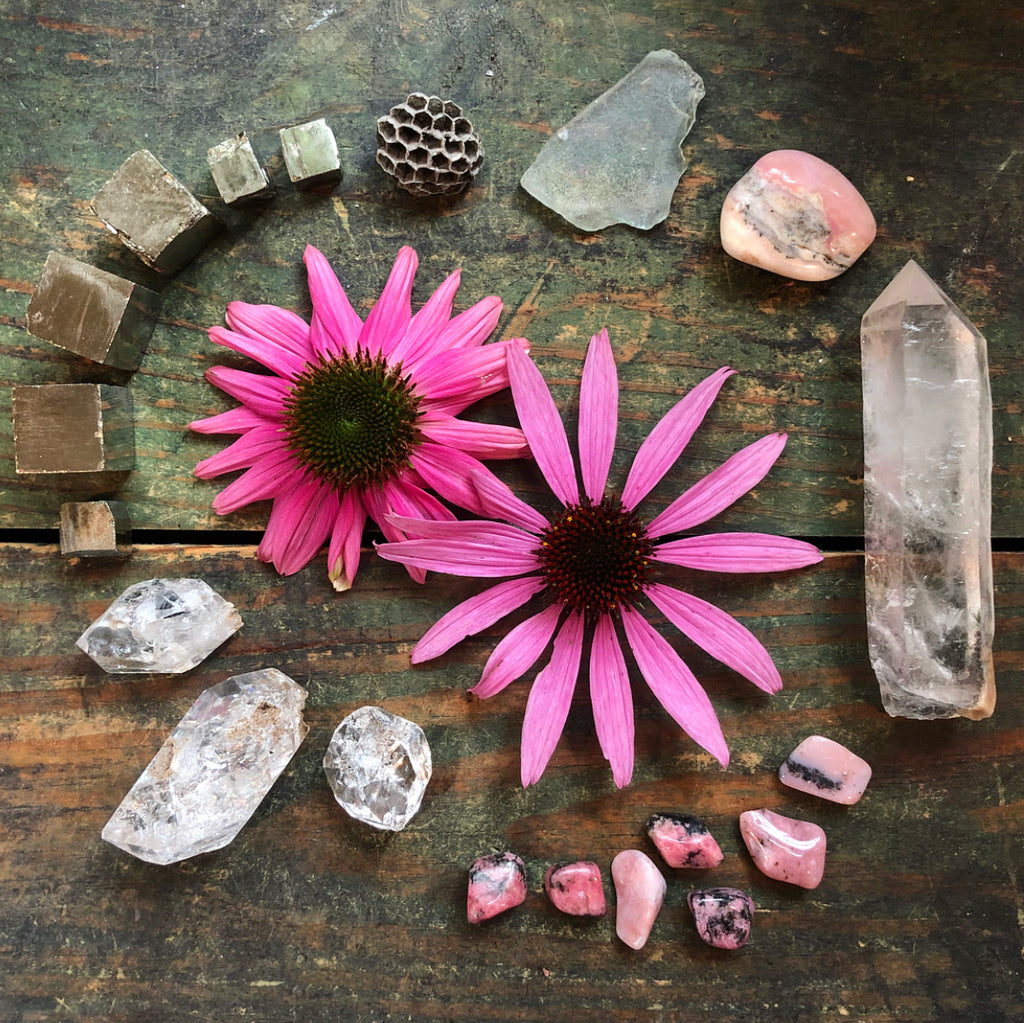plant magic RSS
Red Clover
RED CLOVER // Trifolium pratense Key Constituents: phytoestrogenic isoflavones (genistein, diadzen, formononetin, biochanin), volatile oil, coumarins, cyanogenic glycosides, vitamins, minerals, salicylates, polysaccharides Actions: Alterative, Expectorant, Anti-inflammatory, Antispasmodic Energy: Cooling & Moistening Red clover is a perennial in the pea family which, although native to Europe, grows freely throughout the world in fields, meadows, lawns and roadsides. The flowering tops and leaves are used in teas, tinctures, or infused oils. It is rich in protein (including all of the amino acids) as well as minerals and vitamins, such as vitamins B and C, calcium, magnesium, thiamine, niacin, phosphorus, potassium, nitrogen, and iron. It tastes...
Echinacea
ECHINACEA Echinacea purpurea & E. augustifolia Key Constituents: polysaccharides, glycoproteins, echinacoside, echinacin, polyacetylenes, betaine, caffeic acid glycosides, inulin, sesquiterpene esters, alkamides, volatile oils, flavonoids Actions: alterative, immune stimulant, immunomodulant, analgesic, antibacterial, antiviral, sialagogue Energy: Cooling Echinacea, or purple coneflower, is probably the most well known/frequently used herbal supplement in the United States. While there are nine different species grown throughout North America, two of them, E. purpurea and E. augustifolia are the most used and most widely studied. Herbalist argue fervently over which has the most medicinal value but ALL variants process the phytochemicals that improve the immune system. Echinacea is an immune system stimulant and modulator...
Violet
VIOLET Viola odorata and V. sororia Key Constituents: Mucilage, flavonoids, phenolic glycosides, saponins Actions: alterative, anti-inflammatory, antioxidant, antipyretic, expectorant, diuretic, nervine Energy: Cooling, pungent, moistening Sweet, gentle violet has a long history as a cough remedy and upper respiratory aid. She has also been used in treatments for urinary tract infections and her anti-inflammatory nature makes it a go-to for rheumatism as well as skin issues such as eczema, rashes, hives, and cradle cap. Violet uplifts and soothes the heart and spirit, particularly in times of grief and heartache. Her soothing and cooling energy can also be used to expel anger. She is ruled...
Dandelion
Dandelion Taraxacum officinale Key Constituents: Vitamins A and B. Leaf: calcium, potassium, iron, carotenoids, coumarins. Root: potassium, calcium, phenolic acids, taraxocoside, inulin. Actions: diuretic, cholagogue, bitter, tonic, hepatic, alterative, aperient. Energy: Cooling, pungent, drying. The name is derived from the Old French dent-de-lion, meaning “tooth of a lion” or “lion’s teeth”, also known as cankerwort, monk’s head, priest’s crown, swine snout, wild endive and witch gowan. A perennial in the aster family and found….EVERYWHERE. Though often considered a “weed” and unwanted, the dandelion was used as food and medicine by at least 22 Native North American tribes for tonic effects,...
Calendula
I was recently asked why so many Cattail products contain rosehip seed oil and it got me thinking, that I don't talk nearly enough about these awesome ingredients. While there's tons of info in the shop listings, it might be more fun to have a more cohesive collection about the plants I use. Materia medica is a Latin term for the body of collected knowledge about the therapeutic properties of any substance used for healing. So here we go, the first post in the Cattail Materia Media and today I'm starting with Calendula since this powerhouse is found in SOOO...




